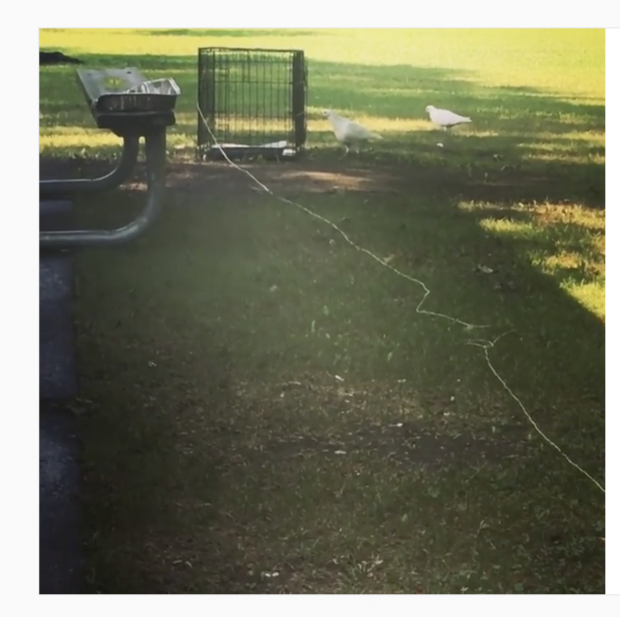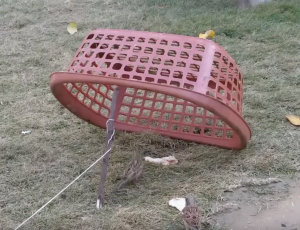Guest Post by Cynthia Bardouka-Large

Audrey Kane rescued these lost DIY “dove release” survivors
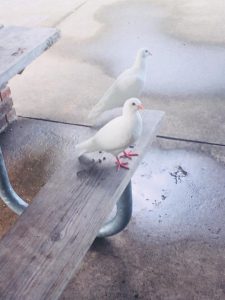
These young King pigeons, rescued by Audrey, were living on borrowed time (domestic with no survival skills, easy prey for every predator).
The people who contact Palomacy often have no previous experience with pigeons or bird rescue. They did not wake up in the morning expecting to cross paths with a pigeon, but then an unexpected guest lands in their backyard, or on their roof, and it seems like something other than a random city pigeon. Perhaps it has an unusual appearance, or bands on its legs, perhaps it is alone with no flock, perhaps it seems weak or unable to fly. There’s no doubt that this is a pigeon in need of help, either because it is ill, starving, or a domestic breed lacking in survival skills. Pigeons and doves are preyed upon by hawks, ravens, gulls, cats, raccoons, rats, and more and, if you can catch the bird, she needs to be caught.
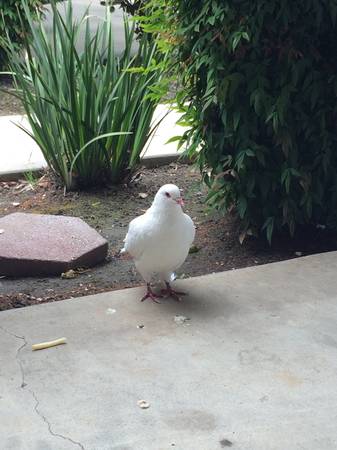
King pigeon Pearl asking for help. (We call this self-rescue.)
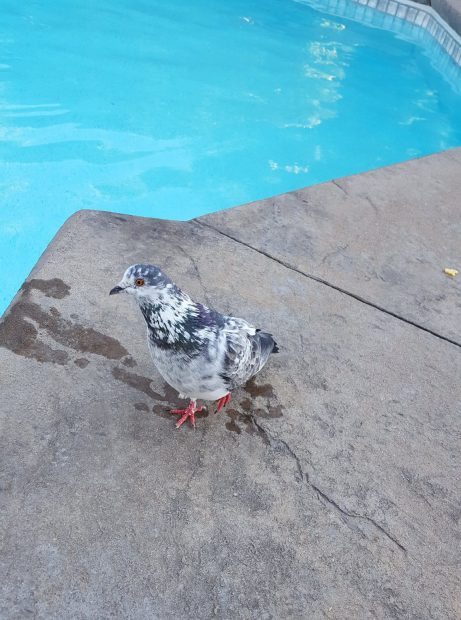
Domestic Roller pigeon Francesco self-rescued (http://www.pigeonrescue.org/2017/08/29/what-kind-of-bird-is-this/)
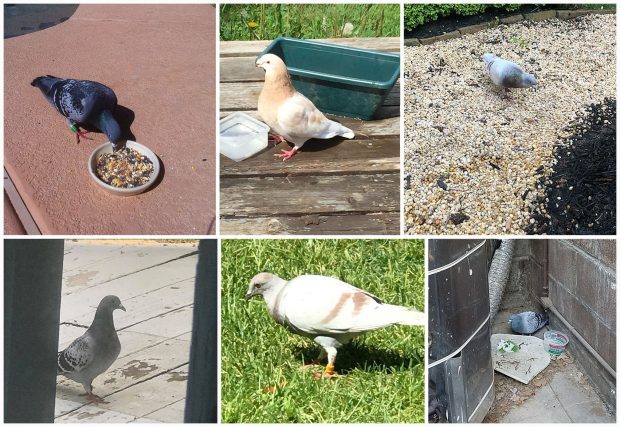
The “sport” of pigeon racing creates lots of lost, starved and/or injured domestic pigeons who need help
But how to catch?
First, rest assured that catching a pigeon is indeed possible, and safe- for both the bird and for you. Your catching the bird will be a lot safer for her than if a predator catches her. You will not scare a pigeon to death or give her a heart attack. And pigeons are harmless to us. They can’t really bite (no teeth and their beak is soft and weak) and, contrary to popular belief, you are highly unlikely to ever be made sick by a pigeon. There are very few diseases that you can catch from them and you are far, far more likely to get sick from a dog or cat (or be struck by lightning, actually). Simple soap-and-water hand washing after handling any animal can reduce the chances of illness to near zero.
So, let’s catch the pigeon!
There are a few different methods that have a good success rate. Much will depend on what you are most comfortable with and what kind of shape the pigeon is in.
The first and easiest method is simply to scoop the pigeon up in your hands. People often tell us that they have found a pigeon that seems exceptionally tame and friendly and allowed itself to be picked up. If you can just pick it up, though, there’s a good chance that the pigeon is in real trouble. It may be starving, dehydrated, and/or injured. The Palomacy network (join here) can help you find a pigeon-friendly rescue or avian vet, and will advise you on getting the bird emergency and supportive care.
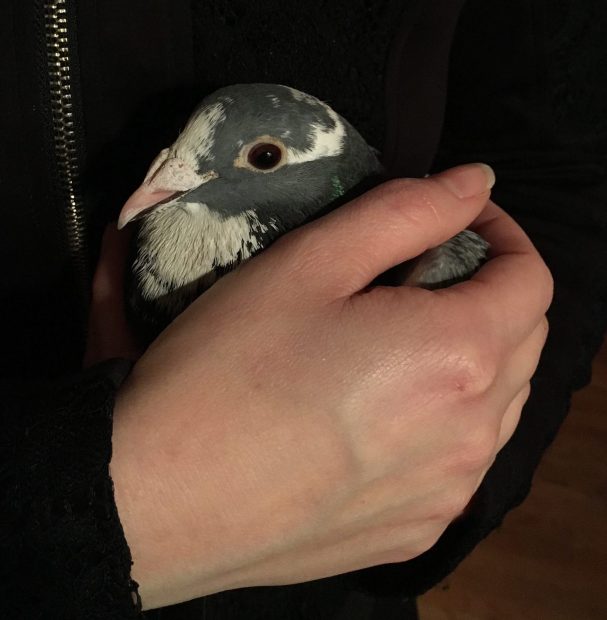
How to hold a pigeon
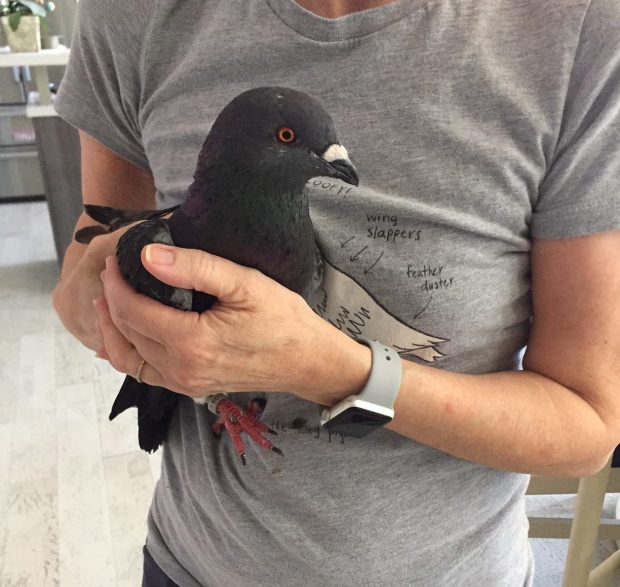
How to hold a (big!) pigeon
A bird that tries to get away from you, but is weak or unable to fly, can often be walk-herded into a corner or inside through an open door and then caught (by hand or with a blanket, towel, or sweater). Drop the cloth over the bird and gently pick it up inside the cloth. Make sure the bird’s wings are folded against its sides, and hold it so that your hands encircle the wings and body, to prevent panicked flapping. A bird in this condition will likely need to be assessed by an expert.
Is your visitor lively? Flies away when you get too close? It’s good to see a strong and healthy pigeon, but this will present a challenge in actually getting your hands on the bird. The method that most often succeeds in catching a bird that is unwilling to be caught, is the crate-and-string method. You’ll need a cage or crate of some kind — a black wire dog crate works well. Put seeds and water deep in the center of the cage (beyond the reach of a clever bird who pokes her head in from the sides or back), and a thin trail of seeds leading up to the cage door (not too much, the bird needs to be hungry to risk entering what they know is a trap). Pigeons are especially fond of chopped peanuts and safflower seeds, but an ordinary bird seed mix for either pet or wild birds will work. Even rice -cooked or raw- can work in a pinch (there is a persistent myth that rice is harmful for birds, but it’s actually fine to use) or dry lentils, quinoa, crushed cereal, etc. will work for a hungry bird.
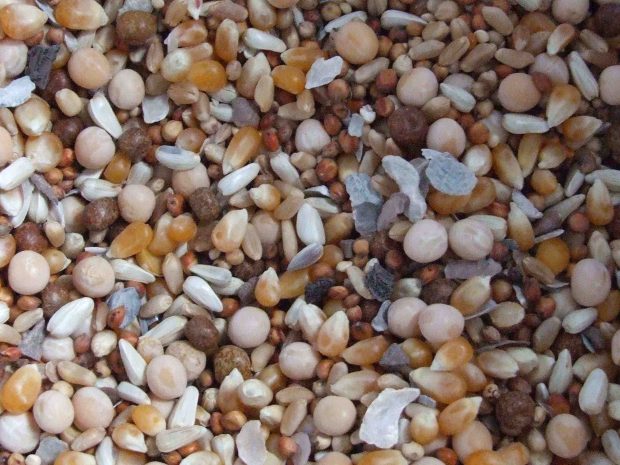
This is pigeon feed & any similar bird or people food works for a hungry pigeon
You’ll want to tie a long piece of string to the cage door in such a way as, when you pull it, the door pulls closed, and then sit at some distance, with the string in your hand. You might need to be out of the bird’s line of vision if it is particularly skittish. Eventually the bird should enter the cage to get the food, at which point you will pull on the string to close the door. Be patient. This can take some time (days even, just leave the door open when you’re not around & only put food inside so they have to go in) but is a very reliable and bird-friendly method. If the pigeon panics after the door is closed and starts thrashing around, cover the crate with a blanket to help calm her and bring the crate and bird indoors to safety. (You can’t leave her outside as predators can do terrible damage to an unsafely confined bird.) And don’t feel badly about having caught her. You most likely just saved her life and she’ll calm down.
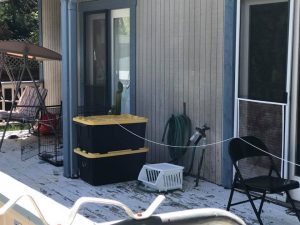
Crate rigged to catch a domestic but shy pigeon
Another method for catching a healthy unwilling pigeon is what we call the Wile E. Coyote box trap (see a video here). Take a medium size box or laundry basket, turn it upside down and prop up one end with a stick. Place food and water underneath the box, with a trail leading up to it. Tie a string to the bottom part of the stick, and sit at a distance away with the other end of the string in your hand. When the pigeon ventures under the box to get the food, pull the string to remove the stick, and the box will fall, trapping the pigeon underneath.
You will at this point need to carefully reach underneath the box to get the pigeon. You won’t be able to see what you’re doing, because if you lift the box too high the pigeon will escape. You might try putting a big blanket over the box and yourself, while you try to catch the pigeon. Your neighbors will wonder about you. But it can work.
You can also buy or create a humane trap with a one-way door so that once they’ve gone in, they can’t get back out. (Monitor the trap closely though and do not leave out unsupervised or overnight. Once trapped, the bird will attract and be terribly vulnerable to predators including rats, cats, hawks, raccoons, ravens, gulls, dogs, etc.)
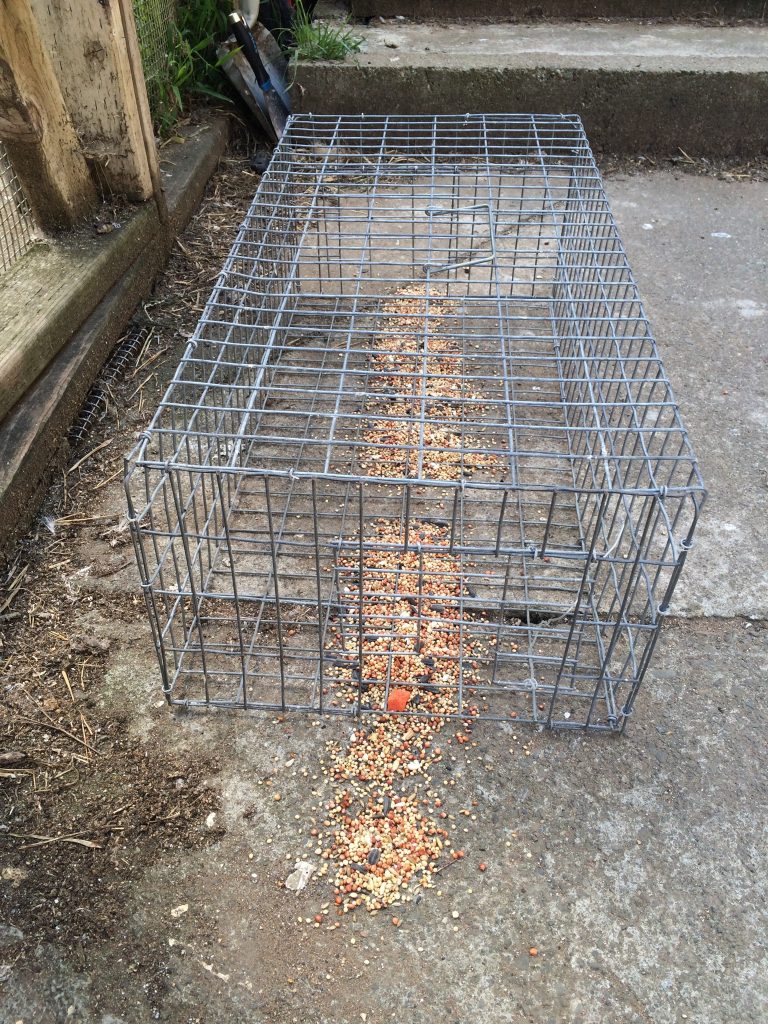
Humane trap (one-way door) baited with bird seed
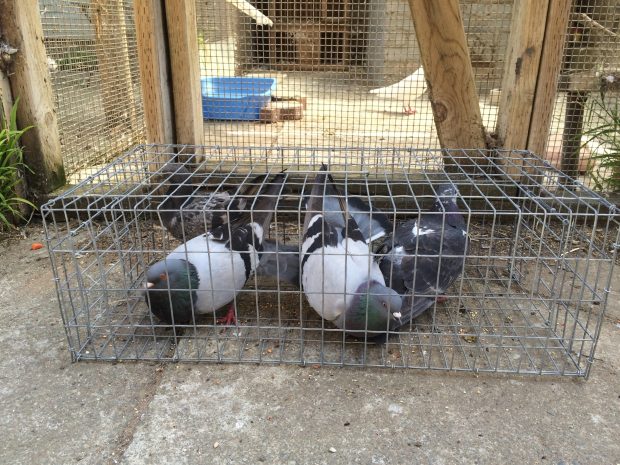
If you catch extra pigeons, you let them go once you’ve secured the one who needed rescuing
A third method for catching a pigeon is to find where it is roosting at night. Pigeons have very poor night vision, and tend to hold still in the dark if they sense danger approaching, hoping that it passes them by. You may be able to climb a ladder and grab the pigeon with your hands. This works best if done in the dark so turn lights off and let your eyes adjust (yours will, the pigeon’s won’t). Then very quietly and without hesitation, grab the bird with both hands around the body. Be prepared for her to startle and try to get away. Don’t let go and make that first grab count because if she gets away, she’ll risk flying off even in the dark.
The final method is one that takes a bit of practice, plus good reflexes and careful timing. It is best used on a pigeon that is hanging out with a wild flock, and it’s the method that we use for “destringing” work, when we are trying to catch wild pigeons who are suffering from injuries to their feet caused by string and debris wrapped around their toes (ever wondered why city pigeons often have missing toes or deformed feet? Now you know!) With this method, you’ll spread a generous amount of food on the ground, in a line that measures three or four inches wide and about a foot and a half long. Stand fairly close to the food with your feet spread a distance apart. The pigeons should approach and cluster around, trying to eat as much as possible and certainly more than the pigeons on either side of them. They will be eyeing the food and each other, while you stand nearby, periodically sprinkling more food. Keep your eye on the pigeon you want to catch. Slowly advance until your open hand is hovering, palm down, immediately above the pigeon, then, in one swift motion, drop your hand down, pinning the bird to the ground. It really helps to practice this multiple times, using a shoe or a loaf of bread in place of the pigeon. You’re going to be going very quickly from a standing to a crouching or lunging position, and you don’t want to topple over, so practice the motion until you feel confident.
It may look like the pigeon is being crushed in the videos but we promise you- she’s not. The catcher’s open fingers hit the ground making a basket of sorts around the bird so she’s pinned but not harmed so that they can then remove the painful, crippling entangled string from her feet (see more here).
If you try and miss, the pigeons may scatter and be skittish for a time, but overcoming their caution is sometimes just a matter of moving the food to a slightly different location. You usually get multiple chances. This is not because pigeons are stupid (they are not), but because pigeons are more trusting than most birds (and very hungry). Despite a long history of mistreatment at the hands of human beings, their species, in general, has a benevolent view of ours. It’s just one reason we do the work we do at Palomacy.
Once caught, you must bring the bird indoors to safety. The vast majority of cages are made only to confine a bird indoors and are not at all safe outside. Leaving a bird outdoors in an indoor cage is basically creating a foraging toy for predators. Hawks, raccoons, cats, rats can all do terrible damage to an unsafely caged bird, right through the bars. (Learn about cage safety here.) Once safely indoors, you need to find a pigeon-friendly expert to help you assess the bird. Many are in critical condition by the time they are caught but recognizing that and supporting them through it takes knowledge and experience. The fastest way to get guidance and referrals is by joining our Palomacy Help Group and posting the situation, your location and photos of the bird. You can also learn some basics here: How to Care for a Rescued Pigeon.
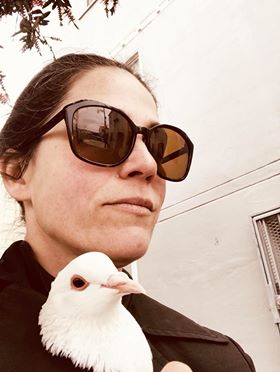
Cynthia Bardouka-Large is a Sacramento based artist. She loves all animals, especially cats, birds, spiders and insects. She and her daughter rescue “stringfoot” pigeons as a hobby, and a year ago they were chosen by a self-rescuing young King pigeon. The whole family has since gone down the rabbit hole of learning about, and advocating for, pigeons as companion animals.

